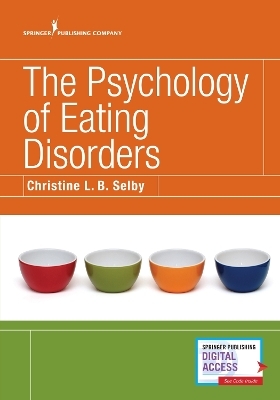
The Psychology of Eating Disorders
Springer Publishing Co Inc (Verlag)
978-0-8261-5501-6 (ISBN)
Offers a clear, concise, up-to-date introduction to eating disorders for students in the health professions
This is a concise, accessible introduction to eating disorders for undergraduate and graduate students in psychology, as well as those specializing in health education and nutrition. Easy to read and grounded in DSM-5 definitions and the most up-to-date research, the text is designed for students in the health professions as well as health professionals seeking a basic understanding of the challenges associated with their diagnoses and treatment.
Written by a licensed psychologist and certified eating disorders specialist, the book describes what eating disorders are and are not, who is likely to develop them, and signs and symptoms of specific disorders. It discusses biological, medical, psychological, interpersonal, and socio-cultural risk factors, and helps the reader to identify those who are at risk for experiencing an eating disorder and how to refer them for evaluation. Scenarios reflect the wide spectrum of people who suffer from eating disorders including young and old, male and female, and athlete and non-athlete. Uniquely, the book also covers the range of reactions someone—including treatment providers—can have to an individual diagnosed with an eating disorder. The text also delivers strategies for treatment and prevention, with overviews of their effectiveness. Print version of the book includes free, searchable, digital access to its entire contents.
Key Features:
Provides an easy-to-read introduction to the full range of eating disorders
Discusses risk factors and warning signs of eating disorders
Discusses evidence-based treatment approaches and prevention
Considers long-term effects of eating disorders
Includes illustrative narratives of diverse individuals with EDs
Authored by a certified eating disorders specialist
Christine L. B. Selby, PhD, CEDS, is an associate professor of psychology at Husson University in Bangor, Maine, and a licensed psychologist in part-time private practice.
Preface
Acknowledgments
Part I: Eating Disorders: What Are They and Who Has Them?
1. The Primary Eating Disorder Diagnoses: General Description, History, and Myths
Introduction
Anorexia Nervosa
Bulimia Nervosa
Binge Eating Disorder
Common Myths of Eating Disorders
Conclusion
References
2. Signs and Symptoms
Introduction
General Signs of Eating Disorders
Signs and Symptoms of Specific Eating Disorders
Related Syndromes and Disorders
Conclusion
References
3. Age, Sex, Race, and Socioeconomic Status
Introduction
Age
Sex
Race/Ethnicity
Socioeconomic Status
Conclusion
References
4. Unique Populations
Introduction
Athletes
Autism Spectrum Disorder
Intellectual Disabilities
Older Adults
Physical Disabilities
Religion
Conclusion
References
Part II: Risk Factors, Corrolates, and Consequences Associated With Eating Disorders
5. Biological and Medical Factors
Introduction
Biological Factors
Medical Factors
Conclusion
References
6. Psychological Factors
Introduction
Weight Concerns
Comorbid Psychiatric Disorders
Personality Factors
Conclusion
References
7. Interpersonal and Sociocultural Factors
Introduction
Interpersonal Factors
Sociocultural Factors
Conclusion
References
Part III: Identifying and Referring Those Who Are at Risk
8. Screening and Assessment
Introduction
Screening
SCOFF Screening Tool
Assessment
Conclusion
References
9. Making an Effective Referral
Introduction
First Line of Defense
What Happens When a Referral Is Made
How Can One Increase the Chances That There Will Be Follow Through on the Referral?
Conclusion
References
10. Identifying and Managing Reactions to Individuals With Eating Disorders
Introduction
Countertransference
The Importance of Having Others to Talk to
Conclusion
References
Part IV: Prevention and Treatment
11. Prevention
Introduction
Types of Prevention
Eating Disorders Prevention
Combined Eating Disorder and Obesity Prevention
Prevention in Middle School
Internet-Based Prevention Programs
Conclusion
References
12. Treatment
Introduction
Treatment Team
Levels of Care
Involuntary Treatment
Mode of Treatment
Treatment Approaches
Conclusion
References
13. Scenarios
Scenario 1: Suzanne, a 10-Year-Old, Throws Food Away at Lunch
Scenario 2: Stephen, a 14-Year-Old High School Student, Was Bullied Because of His Weight
Scenario 3: Brenda, a 19-Year-Old College Student, Has a History of Eating Disorders
Scenario 4: Joyce, a 55-Year-Old Married Mother of Three Adult Children
Scenario 5: Jacinta, a 20-Year-Old Competitive Collegiate Student-Athlete
Scenario 6: Alex, an 18-Year-Old High School Wrestler
Appendix: Professional Organizations and Their Official Stand on Eating Disorders
Glossary
Index
| Erscheinungsdatum | 04.01.2019 |
|---|---|
| Verlagsort | New York |
| Sprache | englisch |
| Maße | 178 x 254 mm |
| Themenwelt | Geisteswissenschaften ► Psychologie ► Persönlichkeitsstörungen |
| Medizin / Pharmazie ► Medizinische Fachgebiete ► Psychosomatik | |
| Medizin / Pharmazie ► Medizinische Fachgebiete ► Psychiatrie / Psychotherapie | |
| ISBN-10 | 0-8261-5501-4 / 0826155014 |
| ISBN-13 | 978-0-8261-5501-6 / 9780826155016 |
| Zustand | Neuware |
| Haben Sie eine Frage zum Produkt? |
aus dem Bereich


